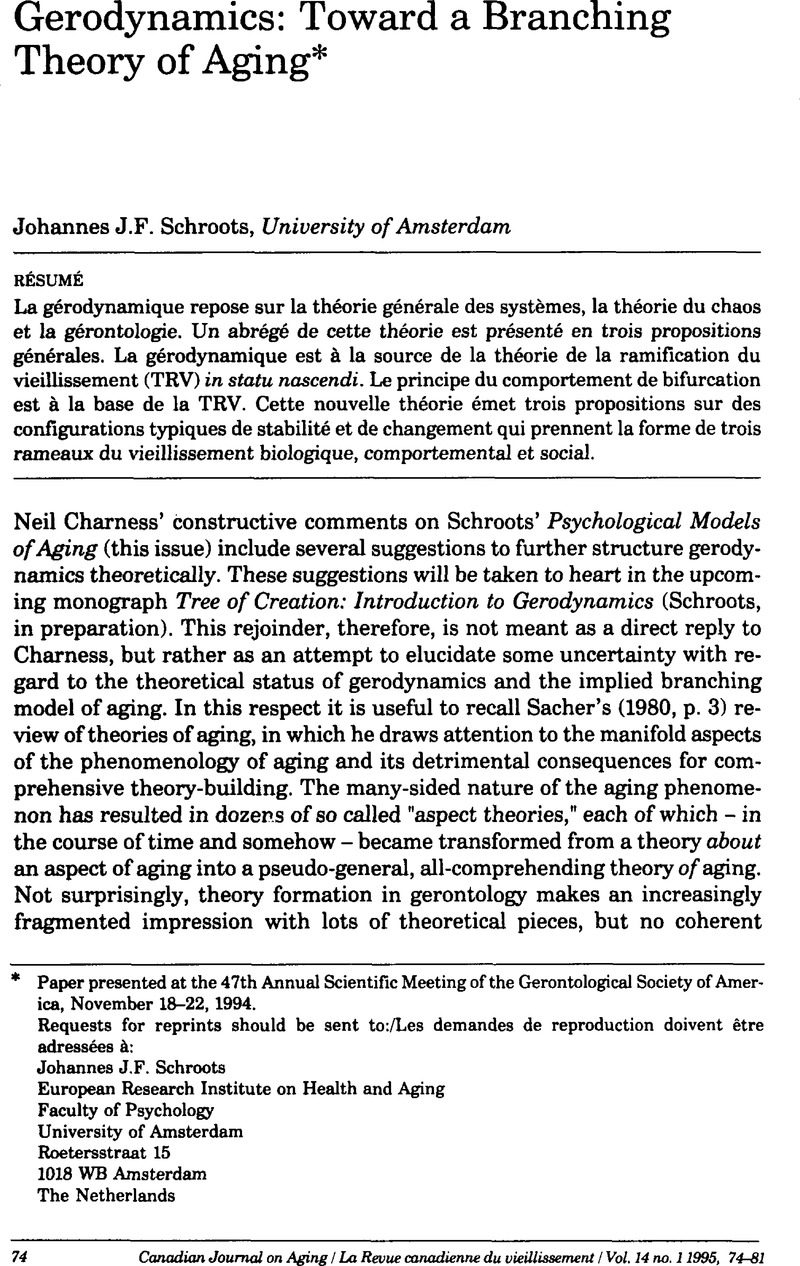Crossref Citations
This article has been cited by the following publications. This list is generated based on data provided by Crossref.
Hendricks, Jon
1997.
Bridging Contested Terrain: Chaos or Prelude to a Theory.
Canadian Journal on Aging / La Revue canadienne du vieillissement,
Vol. 16,
Issue. 2,
p.
197.
Lomranz, Jacob
1998.
Handbook of Aging and Mental Health.
p.
511.
Lomranz, Jacob
1998.
Handbook of Aging and Mental Health.
p.
1.
Hollinger-Smith, Linda
and
Buschmann, MaryBeth
2000.
Failure to Thrive Syndrome.
Clinical Gerontologist,
Vol. 20,
Issue. 4,
p.
65.
Rockwood, Kenneth
Hogan, David B.
and
MacKnight, Chris
2000.
Conceptualisation and Measurement of Frailty in Elderly People.
Drugs & Aging,
Vol. 17,
Issue. 4,
p.
295.
Schroots, Johannes J.F.
2003.
Life-course Dynamics.
European Psychologist,
Vol. 8,
Issue. 3,
p.
192.
Wiesmann, U.
R�lker, S.
and
Hannich, H.-J.
2004.
Salutogenese im Alter.
Zeitschrift f�r Gerontologie und Geriatrie,
Vol. 37,
Issue. 5,
p.
366.
Hogan, Michael J.
2004.
The cerebellum in thought and action: a fronto-cerebellar aging hypothesis.
New Ideas in Psychology,
Vol. 22,
Issue. 2,
p.
97.
Wiesmann, Ulrich
Wendlandt, Stefanie
and
Hannich, Hans-Joachim
2004.
Salutogenese im Alter.
Zeitschrift für Gerontopsychologie & -psychiatrie,
Vol. 17,
Issue. 3,
p.
179.
Wiesmann, U.
Rölker, S.
Ilg, H.
Hirtz, P.
and
Hannich, H.-J.
2006.
Zur Stabilität und Modifizierbarkeit des Kohärenzgefühls aktiver älterer Menschen.
Zeitschrift für Gerontologie und Geriatrie,
Vol. 39,
Issue. 2,
p.
90.
Schroots, J.J.F.
2007.
Encyclopedia of Gerontology.
p.
611.
Shawler, Celeste
2007.
Empowerment of Aging Mothers and Daughters in Transition During a Health Crisis.
Qualitative Health Research,
Vol. 17,
Issue. 6,
p.
838.
Wiesmann, Ulrich
and
Hannich, Hans-Joachim
2008.
A salutogenic view on subjective well-being in active elderly persons.
Aging & Mental Health,
Vol. 12,
Issue. 1,
p.
56.
Wiesmann, Ulrich
Niehörster, Gabriele
and
Hannich, Hans‐Joachim
2009.
Subjective health in old age from a salutogenic perspective.
British Journal of Health Psychology,
Vol. 14,
Issue. 4,
p.
767.
Shmotkin, D.
Shrira, A.
Eyal, N.
Blumstein, T.
and
Shorek, A.
2014.
The Prediction of Subjective Wellness Among the Old-Old: Implications for the "Fourth-Age" Conception.
The Journals of Gerontology Series B: Psychological Sciences and Social Sciences,
Vol. 69,
Issue. 5,
p.
719.
Wiesmann, Ulrich
and
Hannich, Hans-Joachim
2019.
A salutogenic inquiry into positive aging – a longitudinal analysis.
Aging & Mental Health,
Vol. 23,
Issue. 11,
p.
1562.
Górska, Sylwia M.
Maciver, Donald
and
Forsyth, Kirsty
2021.
Participation as means for adaptation in dementia: a conceptual model.
Aging & Mental Health,
Vol. 25,
Issue. 3,
p.
499.



